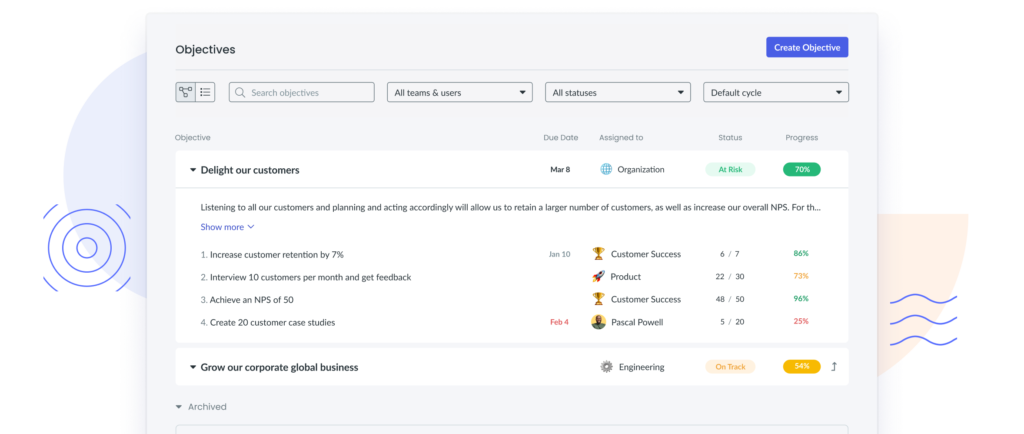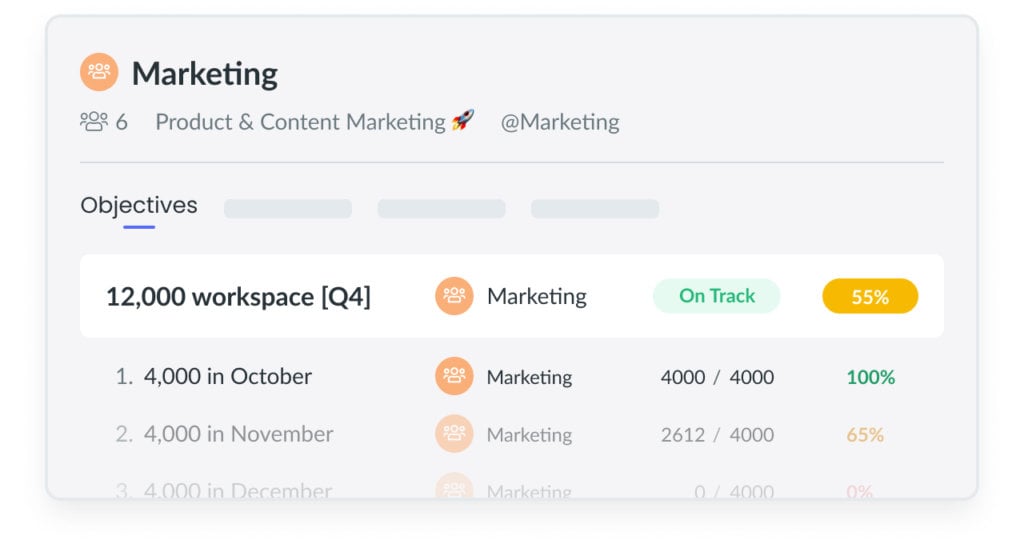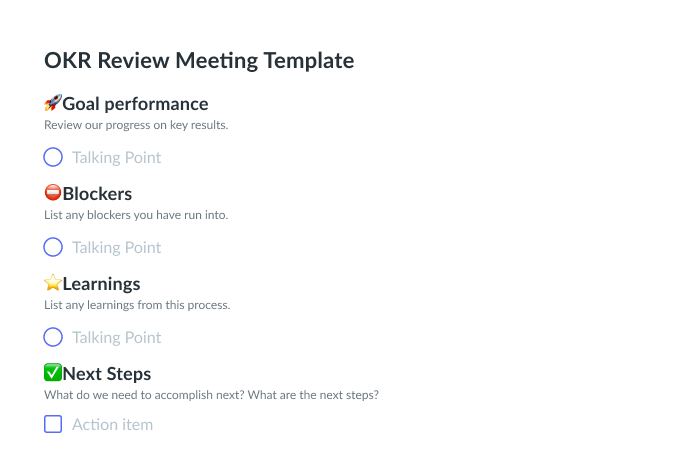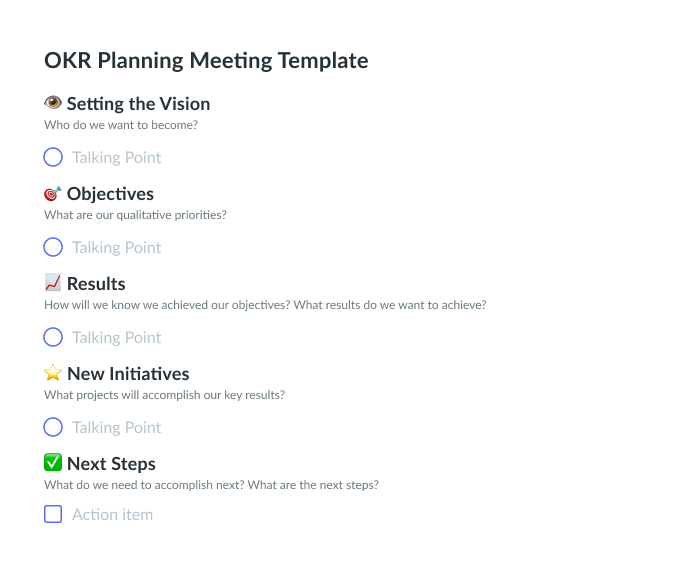How to Write OKRs in 6 Steps
Understanding your objectives and key results (OKRs) is one thing; knowing how to write OKRs is another. Learn everything you need here!
The concept of goal setting isn’t new. But sometimes we seem to forget the benefits that it brings to our lives in both the short and long term. And even more often, we wonder if it’s really making enough of a positive difference at all.
To determine the truth once and for all, one study looked at the effects of setting goals over more than 50 years and found that writing down your goals will bring you significant positive impacts in your work, school, and personal life!
Are you wanting to make goal setting more of a formal practice in your business? You’ve come to the right place.
- What are OKRs?
- Best practices for OKRs
- How to write OKRs in 6 steps
- How to create and track OKRs with Fellow
- Free OKR templates
What are OKRs?
Objectives and key results (OKRs) are used by companies to guide strategic and tactical decision-making. There are two components to this approach. The first part is setting the objective, which is the end goal that you hope to achieve. Objectives tend to be more strategic and can be earned in the long run. Some examples include:
- Be more proactive in sales calls.
- Decrease time spent on patch management in product development cycles.
- Generate more user insights from product releases.
For every objective, you’ll also need to create several key results, which help to measure if the objective was successfully completed. These are more tactical and specific, and can be completed in either the short or long run. Some examples of key results include:
- Call companies with expiring contracts at least 1 month before their contract ends.
- Identify the five most common objections in sales calls.
- Run quality assurance (QA) testing on all new code before it hits production.
- Send at least 50 user surveys to existing customers after every major product release.
OKRs are decided by teams at all levels of an organization. Usually, the C-level team decides on organization-wide OKRs first. From there, subsequent teams each decide on team-specific OKRs that align with the organization-level goals. This helps to ensure alignment across the entire company.

Track objectives as part of your meeting workflow
Stay on top of your team’s goals by clearly recording, defining, and tracking the progress of your OKRs in Fellow’s Objectives tool. The best part? You can quickly review those objectives during your team meetings!

Best practices for OKRs
- Make them measurable
- Make them challenging but realistic
- Be clear and specific
- Celebrate milestones along the way
1Make them measurable
To know if you’ve achieved success, you have to have quantifiable aspects to your OKRs. Try using any existing benchmarks to set higher key results that you would like to hit. Then, determine a timeframe for measurement. Many teams run OKRs on an annual or quarterly basis. You can also opt to set overarching annual goals, with smaller OKRs for each quarter. Taking this approach helps break down high targets into more manageable tasks.
2Make them challenging but realistic
With any goal, you should strive to push yourself and your team to continuously improve. Use the benchmarks that you have today and any historical data on your growth rate to help you determine what a realistic future goal looks like. At the same time, try not to stretch your team too far. Setting unattainable goals is a habit in teams that lack the motivation or resources to bring those ideas to life, meaning you’re even more unlikely to strive further to meet them. If you’re having trouble envisioning what realistic OKRs look like, consider talking to a peer in the industry who has experience with your project scope.
3Be clear and specific
OKRs can be interpreted in a lot of different ways, especially if you have any OKRs that are going to be interpreted by different teams. Making your goals as unambiguous as possible can help ensure that your teams work in the same direction, towards the same end goals. For example, the term “run testing more frequently” can lead to a lot of questions about the type of testing that needs to be done, the systems or products on which the testing should be done, and the quantification of what “frequent” really means.
4Celebrate milestones along the way
A great way to keep your team members motivated is to make sure they’re rewarded for their hard work along the way! Celebrating major milestones keeps up the energy, renews your team’s sense of purpose in the project, and provides an opportunity to give credit to hardworking team members. If you’re setting a higher-than-usual target, this also helps make a far-off end goal seem more manageable.
How to write OKRs in 6 steps
- Develop a plan
- Use an OKR tool
- Seek input from your team
- Create an OKR objective statement
- Write your key results
- Know your company’s goals
1Develop a plan
Create a formal system for how you’ll create, share, and track your OKRs. Having a plan and strategy in place helps your team know where to find the OKRs, how to report on them, and whom to go to if they have any questions.
You should also consider how your team will adapt your OKRs in times of crisis. For example, if the resources required to fuel your OKRs were to dramatically slow down or stop, how will you react? The Harvard Business Review says to focus on the near term, do tasks within your control, and prioritize what’s most important to you.
2Use an OKR tool
Leveraging an online tool is a great way to make your OKRs easily accessible by all team members, regardless if you are working in a remote or in-person environment. Fellow, for example, has an OKR tracking tool integrated into its meeting management platform. This additional feature means that you can list and report on OKR success as part of your recurring meeting agendas. This way, you’ll never forget to include these successes as talking points!

3Seek input from your team
Your team will be putting a ton of effort toward the success of your OKRs, so it makes sense to include them in the OKR development process. Consider hosting a brainstorming session at the beginning of the fiscal year or quarter to talk about things like:
- What challenges are we facing most often?
- What solutions are available for these problems?
- What risks are we willing to take in the next 1, 3, or 6 months?
- Where do we want to be by the end of the next month, quarter, or year?
4Create an OKR objective statement
The first, and probably most important part, of your OKR is the objective statement. This part is crucial to nail down as it sets the overarching direction or strategy for which you want to build key results. Your objective statement should be strategic, but should still be quite defined and narrowed down. Try to avoid a statement that is too general, such as “improving productivity.” Instead, opt for something more specific like “decreasing time spent context switching by 10%.”
5Write your key results
The key results are the specific tasks and sub-goals that need to be completed for the objective to be met. These results should be easily measurable and set within a specific timeframe. Ideally, you’ll have internal or industry benchmarks to compare to when creating these key results. Consider how different team members can contribute to these results, too. Individuals or teams can contribute results to multiple objective statements, or can take ownership of all results under one objective.
6Know your company’s goals
The key to creating OKRs that bring a lot of value to your broader organization is aligning the teams’ OKRs to the strategic goals and OKRs set by the highest level of management at your company. Doing so will help keep all teams “steering in the right direction.” For example, if the C-level wants to focus on selling to start-ups, then it doesn’t make sense for product development teams to continue building or refining a solution designed for enterprise teams, or for marketing and sales to continue promoting value propositions that don’t target start-up companies.
How to create and track OKRs with Fellow
Fellow is a helpful tool that can do a lot to help make meetings easier. Among its many helpful features is a place to track your OKRs across your teams and projects. Here’s how objectives work in Fellow:
- Define the cycle (month, quarter, year) that these OKRs will be worked on
- Add objectives for each department, team, or individual that you are overseeing
- Specify key results (ideally 2-4 for each objective)
- Stay on track by reviewing these goals in your recurring team meetings
Free OKR templates


Parting advice
Adopting OKRs in your organization is a great way to bring a more formal, systematic technique for setting goals to your teams. Keeping your teams involved in building and tracking goals helps all members stay aligned and helps get member buy-in when it comes to the OKRs, meaning you’ll be much more likely to hit your targets. When in doubt about how to set realistic OKRs or how to motivate your team to achieve them, consider getting transparent, honest feedback from trusted team members or reach out to industry peers to learn about their experience on similar projects.










